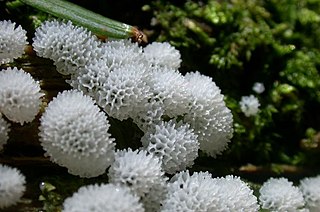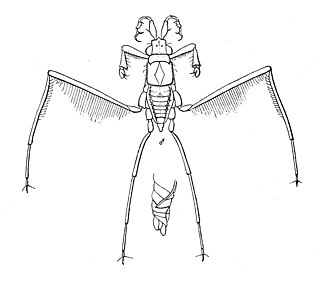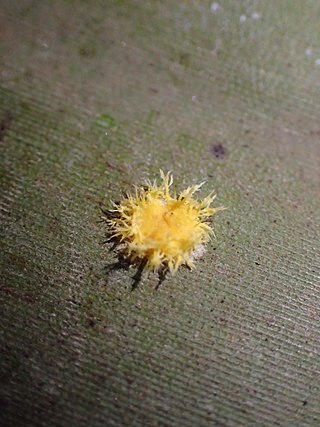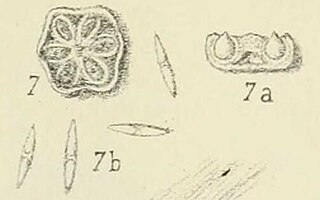
Beauveria bassiana is a fungus that grows naturally in soils throughout the world and acts as a parasite on various arthropod species, causing white muscardine disease; it thus belongs to the group of entomopathogenic fungi. It is used as a biological insecticide to control a number of pests, including termites, thrips, whiteflies, aphids and various beetles. Its use in the control of bedbugs and malaria-transmitting mosquitos is under investigation.
Joseph Harvey Riley was an American ornithologist.
Neotyphodium chilense is a species of fungus in the Clavicipitaceae family, which is an endophyte that lives in the grass Dactylis glomerata in southern Chile. Originally known as Acremonium chilense when it was first described in 1990, it was transferred from Acremonium to Neotyphodium in 1996. Currently, it should be treated as Acremonium chilense since the previous transfer to Neotyphodium is untested.

Beauveria is a genus of asexually-reproducing fungi allied with the ascomycete family Cordycipitaceae. Its several species are typically insect pathogens. The sexual states (teleomorphs) of Beauveria species, where known, are species of Cordyceps.

Cyclura rileyi, commonly known as the Bahamian rock iguana or the San Salvador rock iguana, is a critically endangered species of lizard in the family Iguanidae. The species is native to three island groups in the Bahamas, and is in decline due to habitat encroachment by human development and predation by feral dogs and cats. There are three subspecies: the Acklins ground iguana, the White Cay iguana, and the nominotypical subspecies.

The Hymenogastraceae is a family of fungi in the order Agaricales with both agaric and false-truffle shaped fruitbodies. Formerly, prior to molecular analyses, the family was restricted to the false-truffle genera. The mushroom genus Psilocybe in the Hymenogastraceae is now restricted to the hallucinogenic species while nonhallucinogenic former species are largely in the genus Deconica classified in the Strophariaceae.

Metarhizium is a genus of entomopathogenic fungi in the Clavicipitaceae family. With the advent of genetic profiling, placing these fungi in proper taxa has now become possible. Most turn out to be the asexual forms (anamorphs) of fungi in the phylum Ascomycota, including Metacordyceps spp.

Protosteliomycetes/Protosteliales (ICBN) or Protostelea/Protostelia/Protosteliida (ICZN) is a grouping of slime molds from the phylum Mycetozoa. The name can vary depending upon the taxon used. Other names include Protostelea, Protostelia, and Protostelida. When not implying a specific level of classification, the term protostelid or protosteloid amoeba is sometimes used.

Metacordyceps is a genus of fungi in the family Clavicipitaceae. The anamorphs of Metacordyceps appear to include Metarhizium species.

Lecanicillium lecanii is now an approved name of an entomopathogenic fungus species, that was previously widely known as Verticillium lecanii (Zimmerman) Viegas), but is now understood to be an anamorphic form in the Cordyceps group of genera in the Clavicipitaceae. Isolates formerly classified as V. lecanii could be L. attenuatum, L. lecanii, L. longisporum, L. muscarium or L. nodulosum. For example, several recent papers, such as Kouvelis et al. who carried out mitochondrial DNA studies, refer to the name L. muscarium.

Harposporium anguillulae is a member of the genus Harposporium. It is an endoparasitic nematophagous fungus that attacks nematodes and eelworms and is isolated commonly from field and agricultural soils as well as used as an experimental organism in the laboratory.
Dysphenges rileyi is a species of flea beetle in the family Chrysomelidae. It is found in Central America and North America.

Rheumatobates rileyi is a species of water strider in the family Gerridae. It is found in North America. The genus Rheumatobates is characterized by males having antennae with hook like structures. Males grab females around the head using the antennae and lift them off the water surface. The hind femur appears twisted and a dense cluster of hears are found on the hind femur and tibia in males.

Hypocrella is a genus of fungi in the family Clavicipitaceae.
Nomuraea is a genus of fungi in the family Clavicipitaceae.

Aschersonia is a genus of fungi in the order Hypocreales and family Clavicipitaceae.
Periglandula are a genus of fungi in the family Clavicipitaceae. They live as epibionts, in a symbiotic relationship with two species of plant, Ipomoea asarifolia and Ipomoea corymbosa. They are known to produce ergot alkaloids related to lysergic acid.
Periglandula ipomoeae is a fungus of the genus Periglandula in the family Clavicipitaceae. It lives symbiotically with the plant Ipomoea asarifolia as an epibiont.











